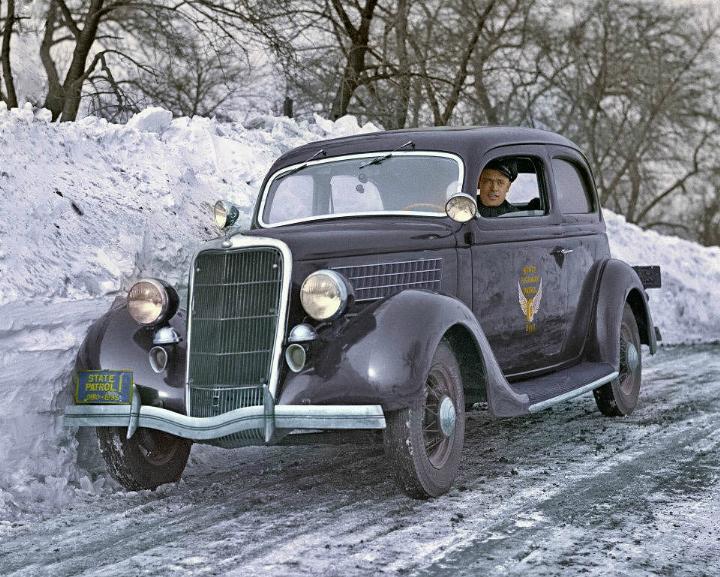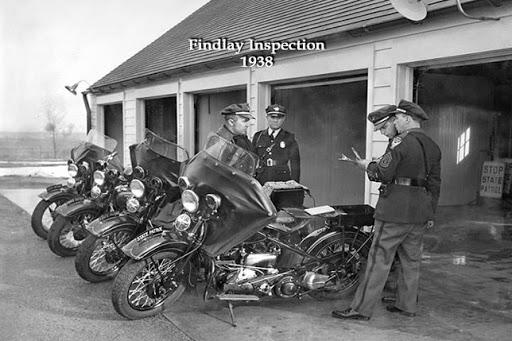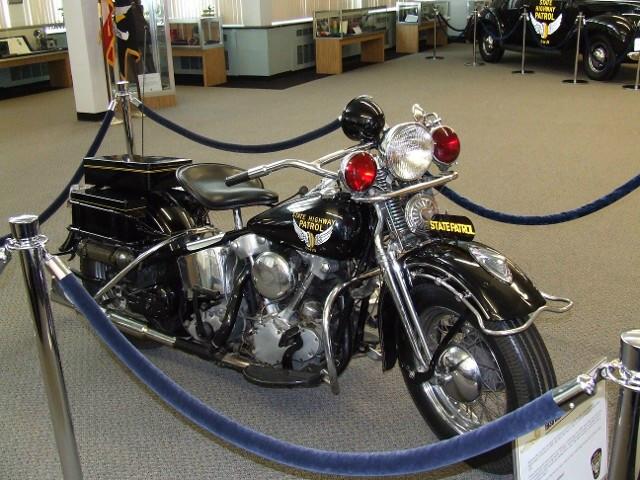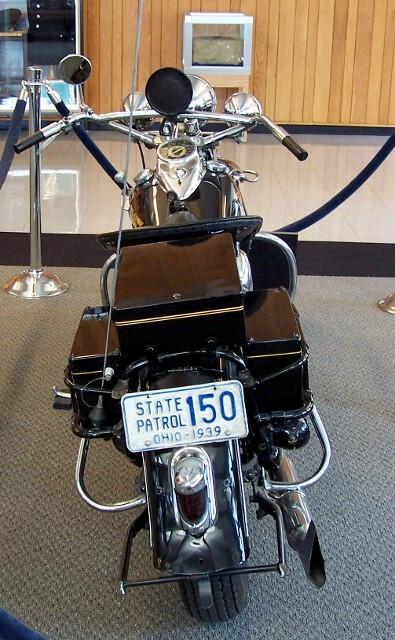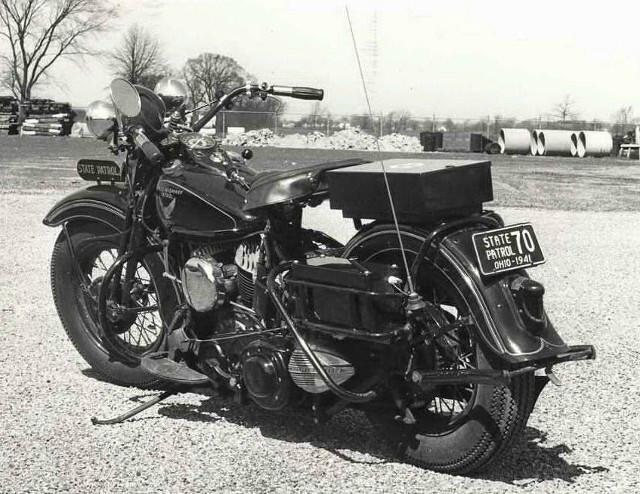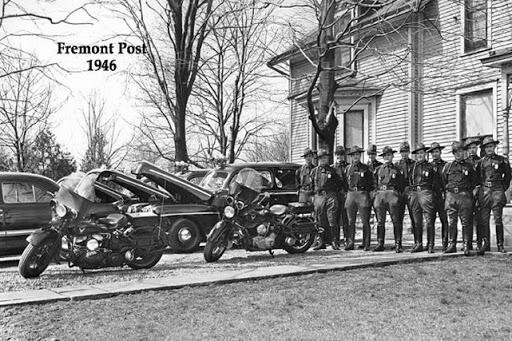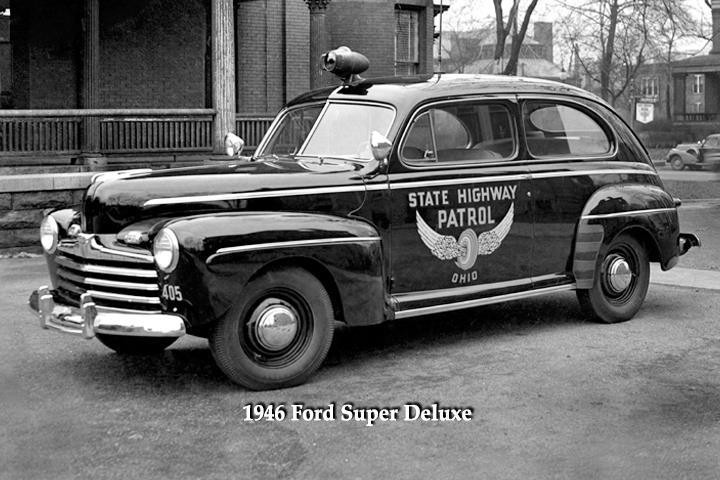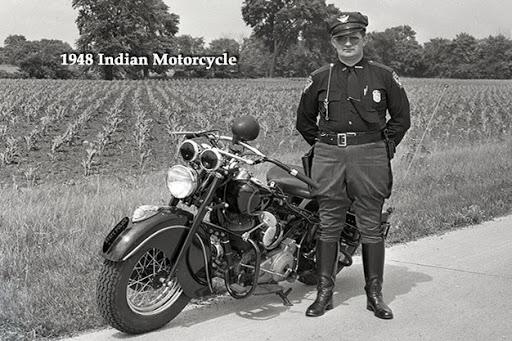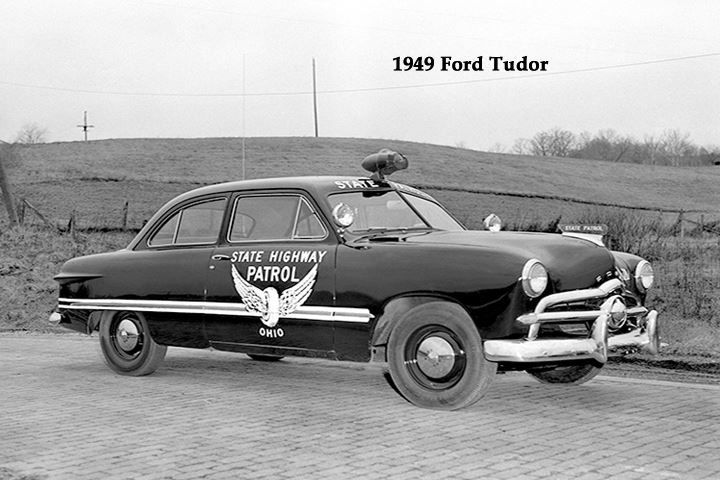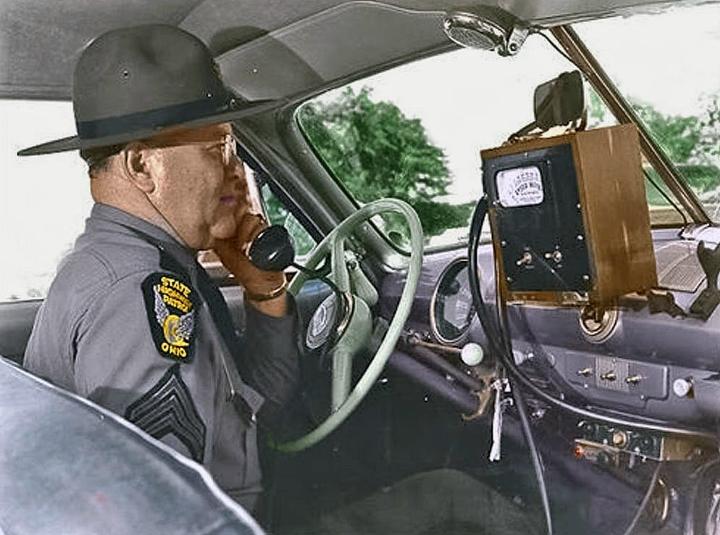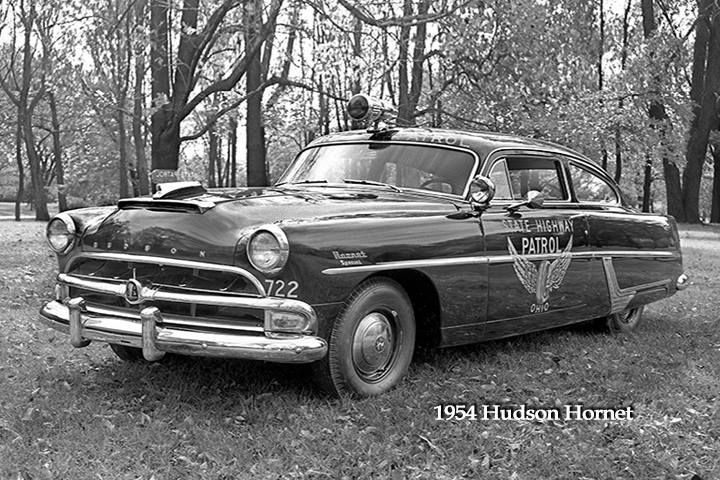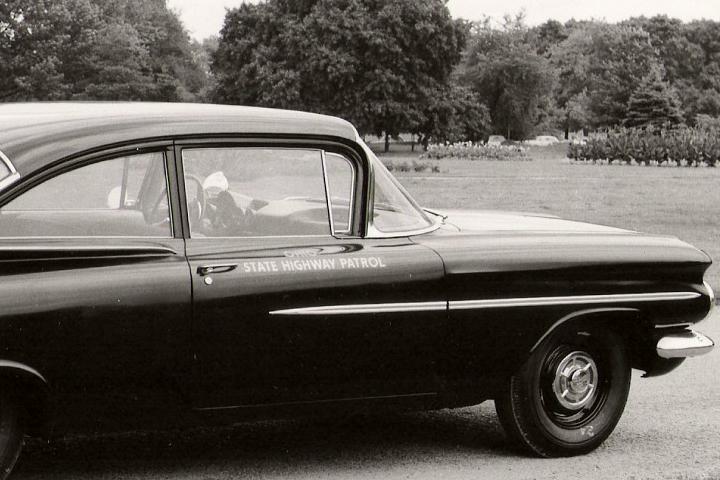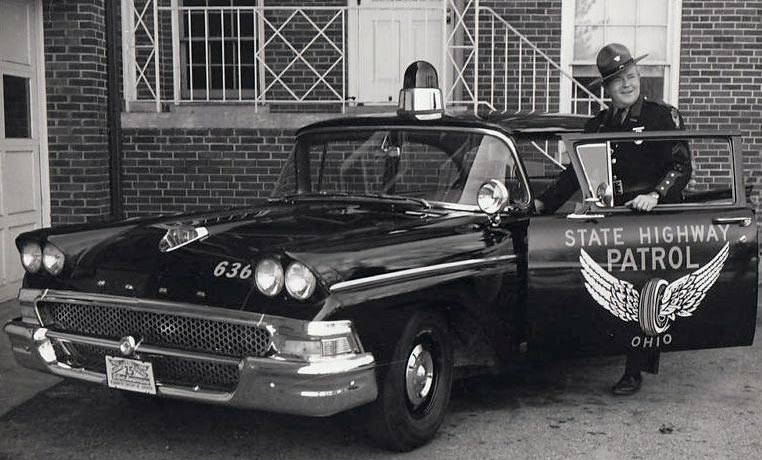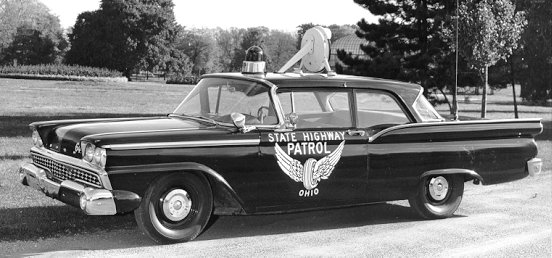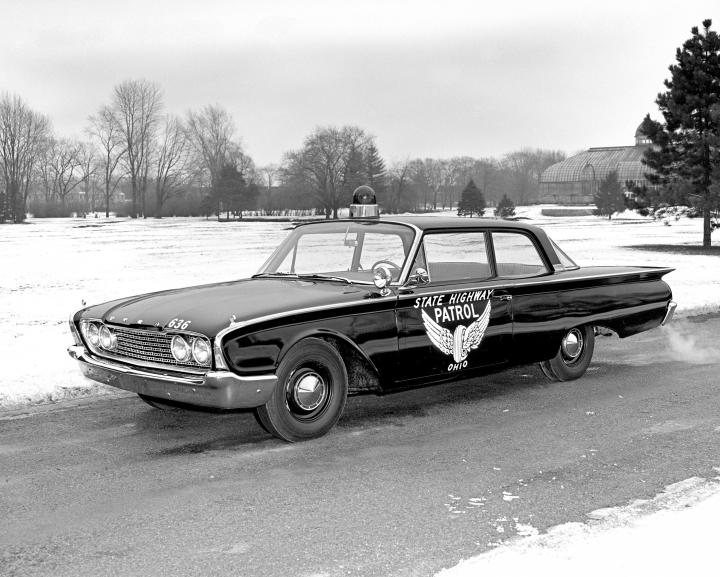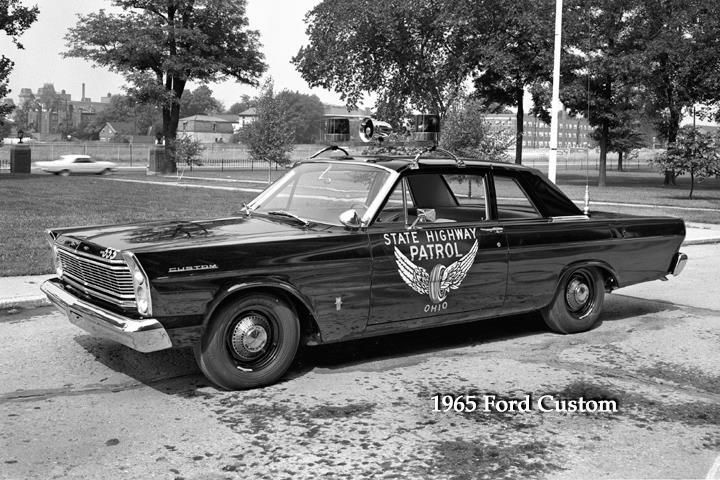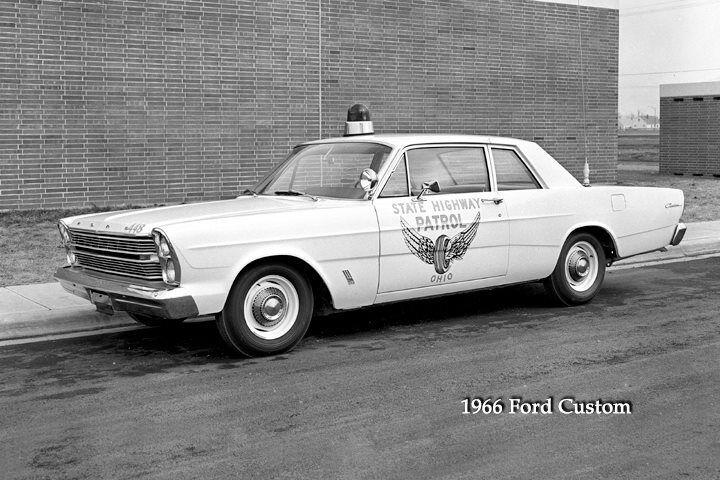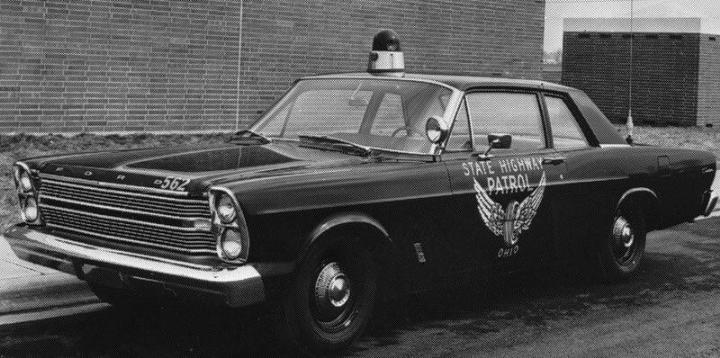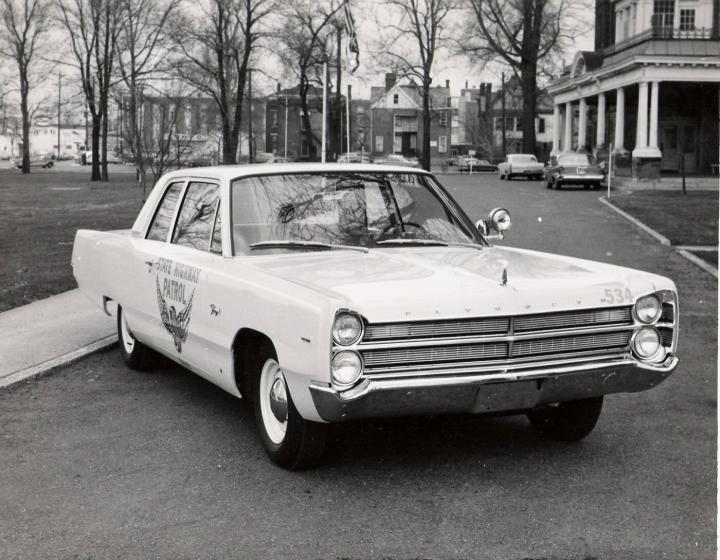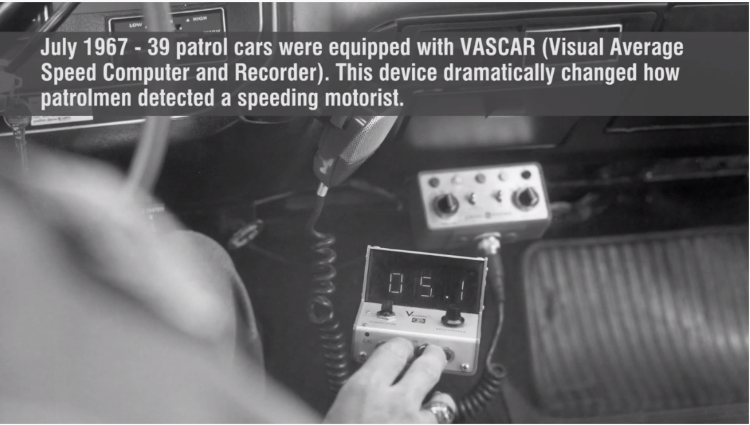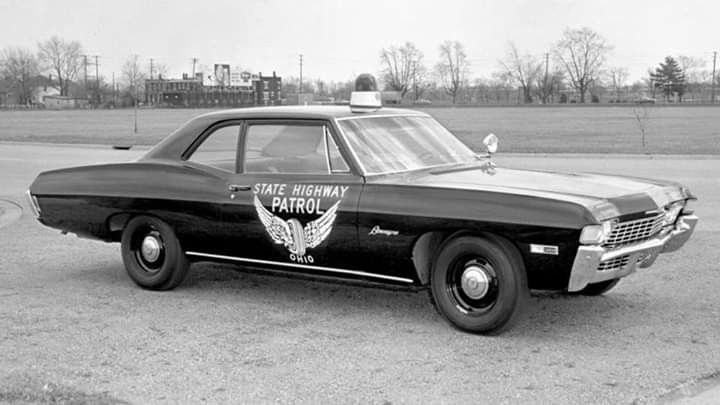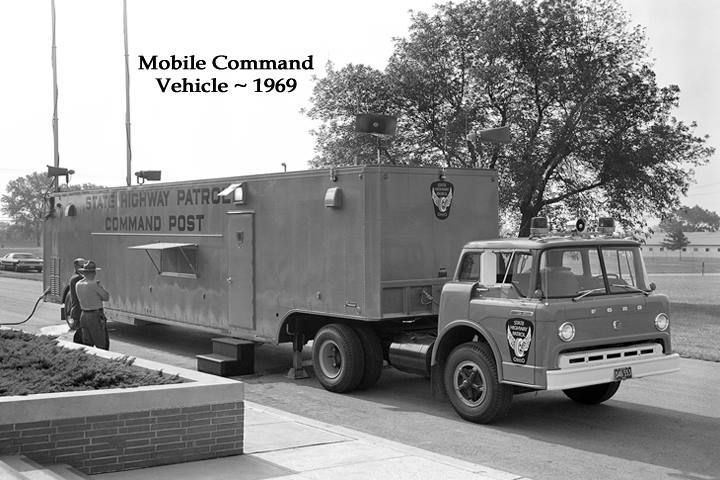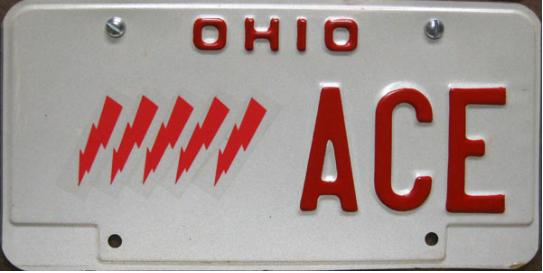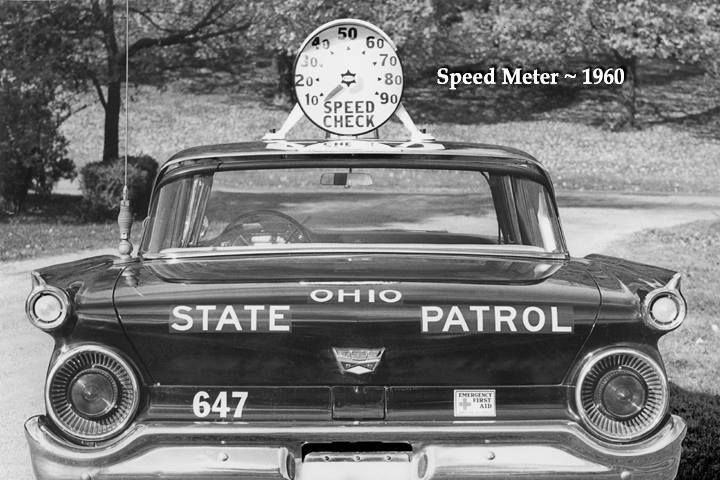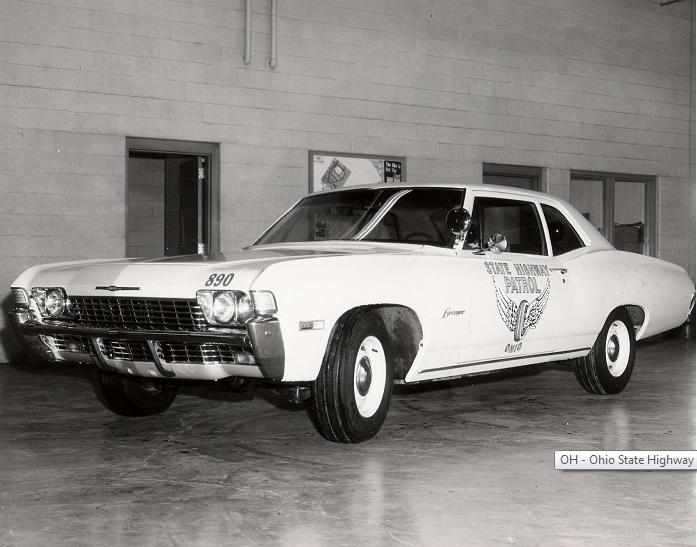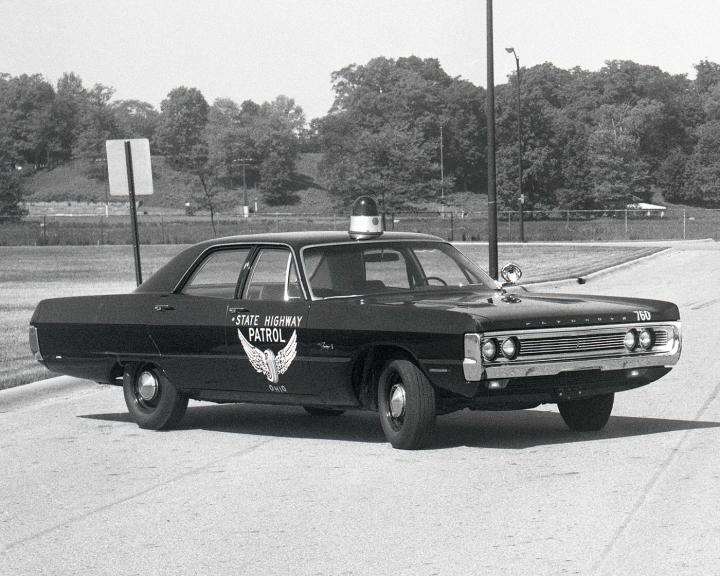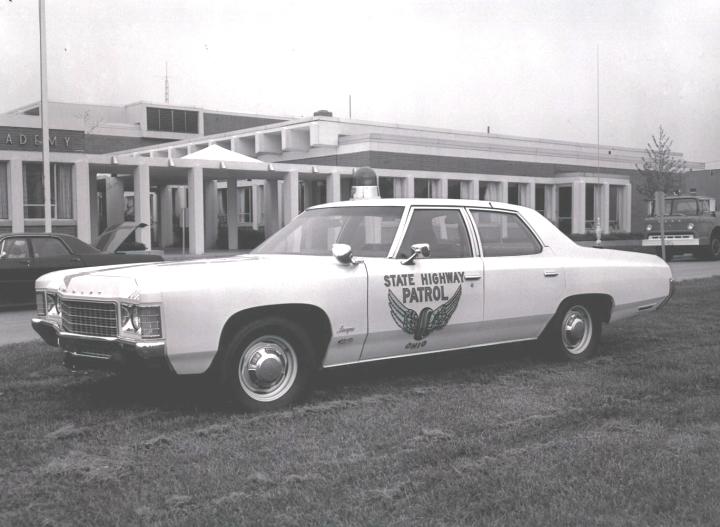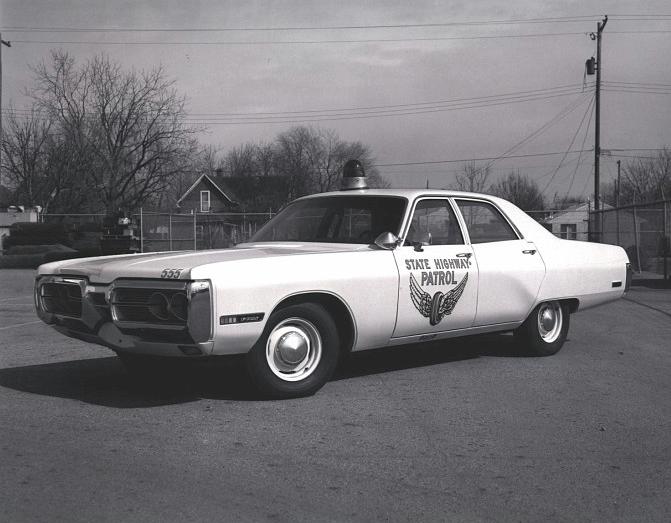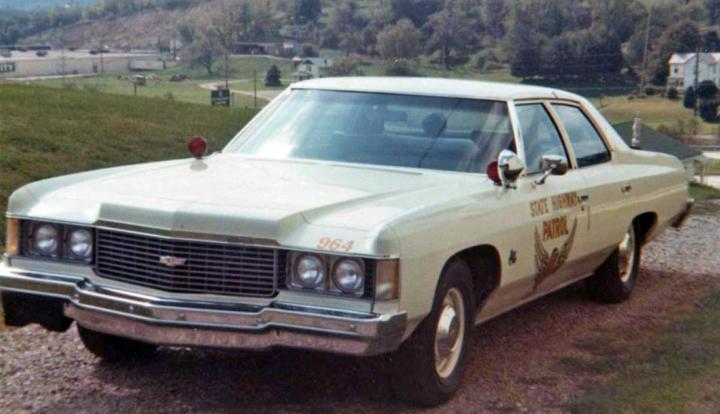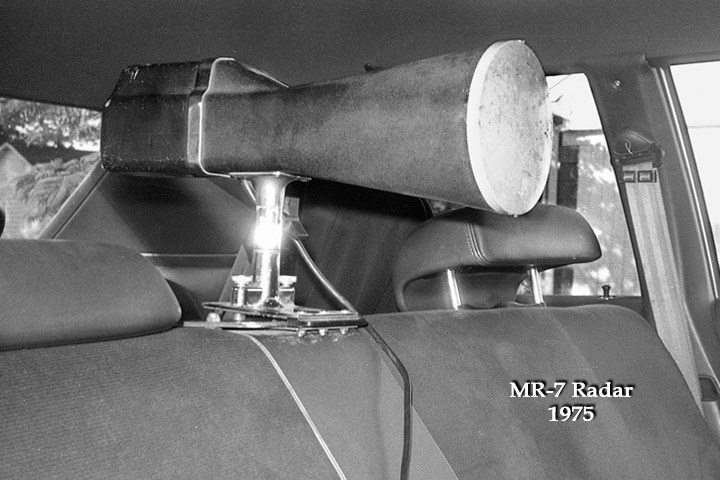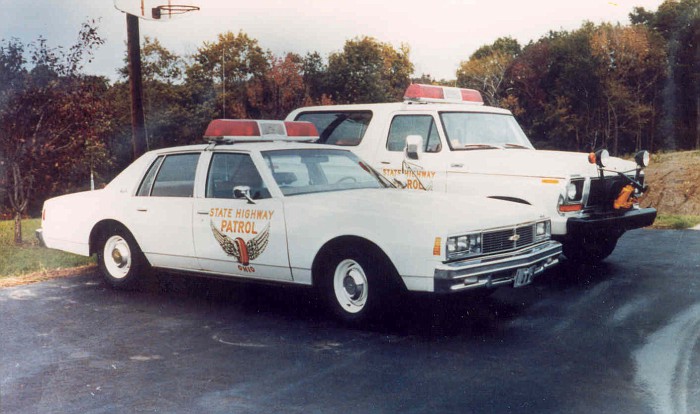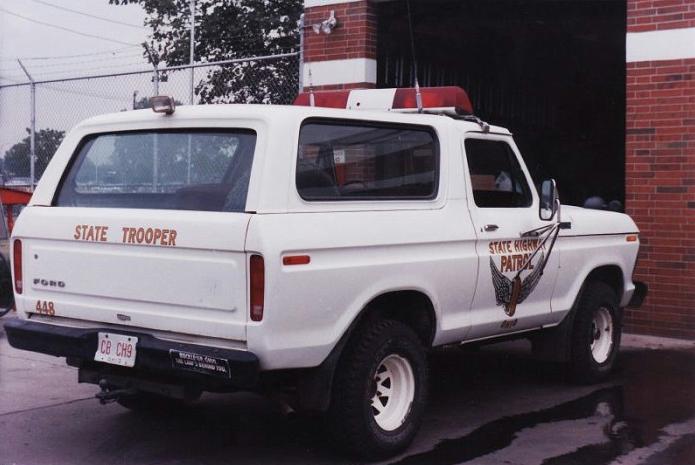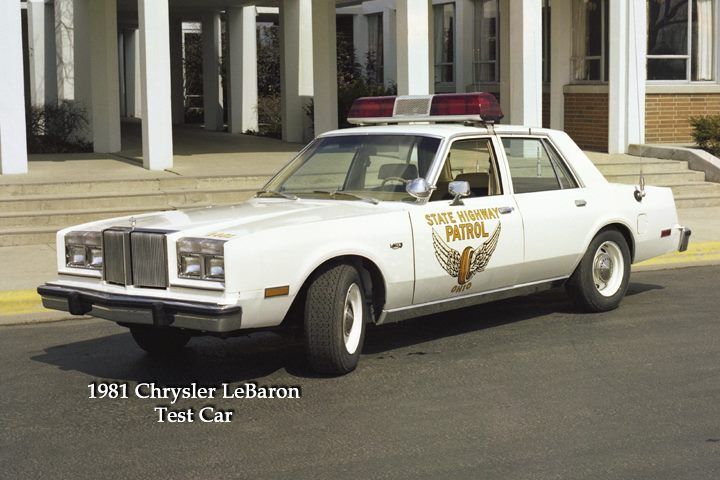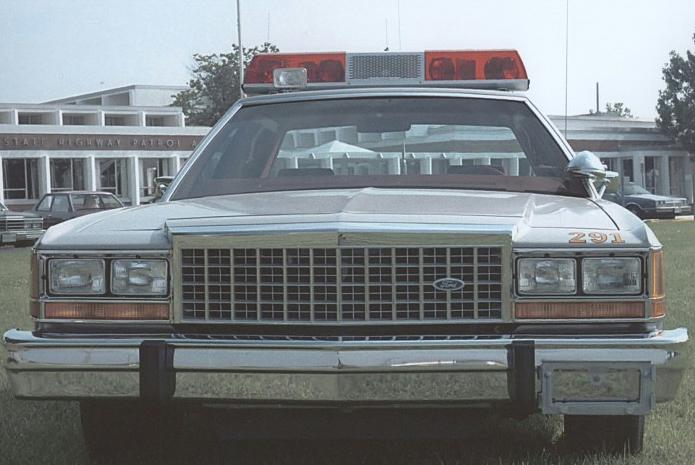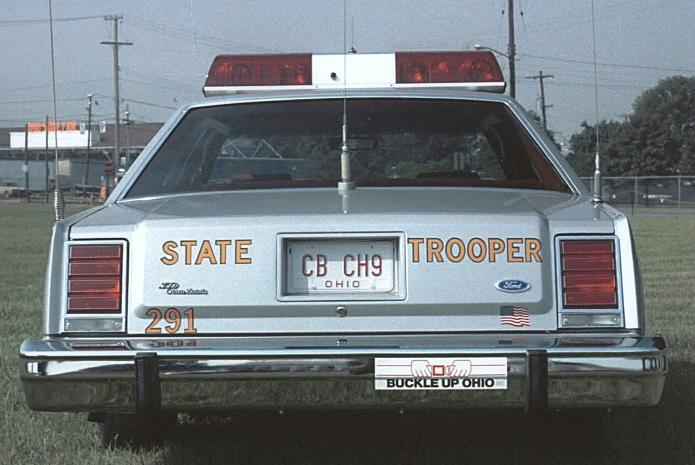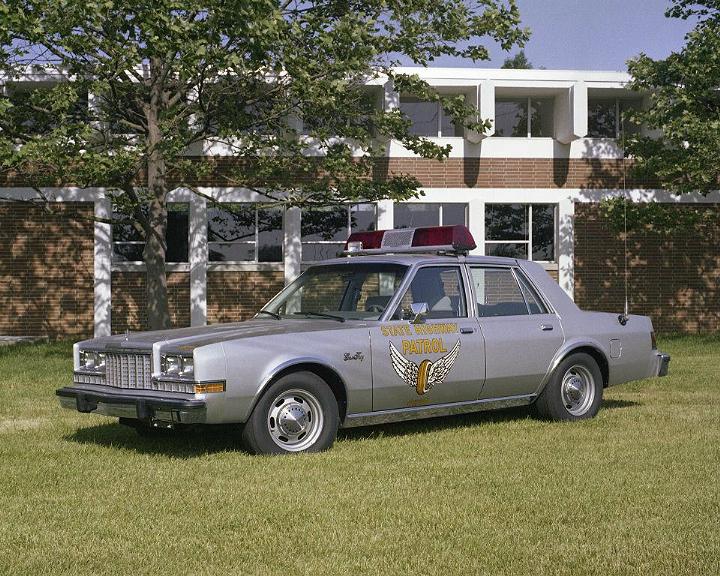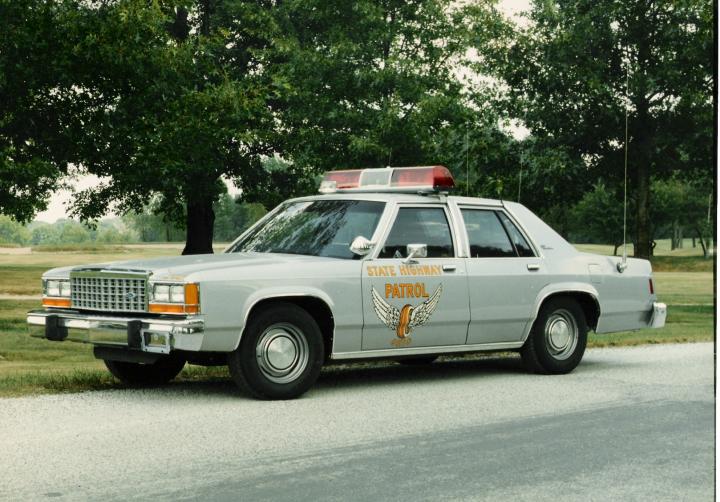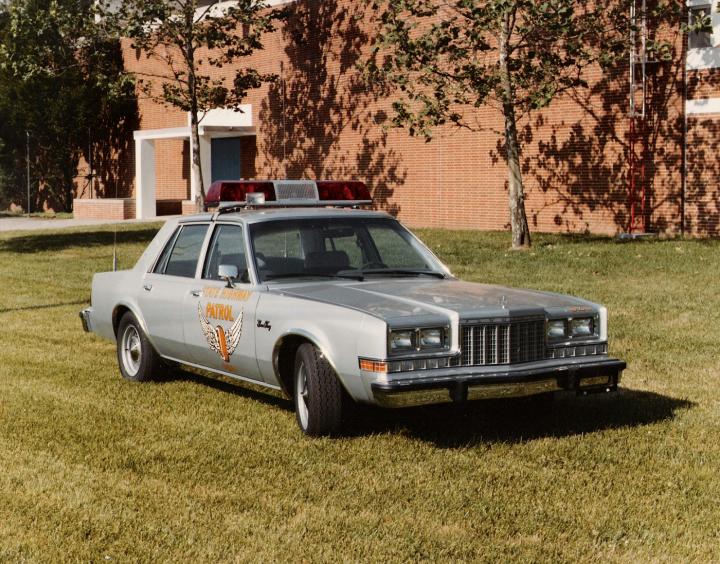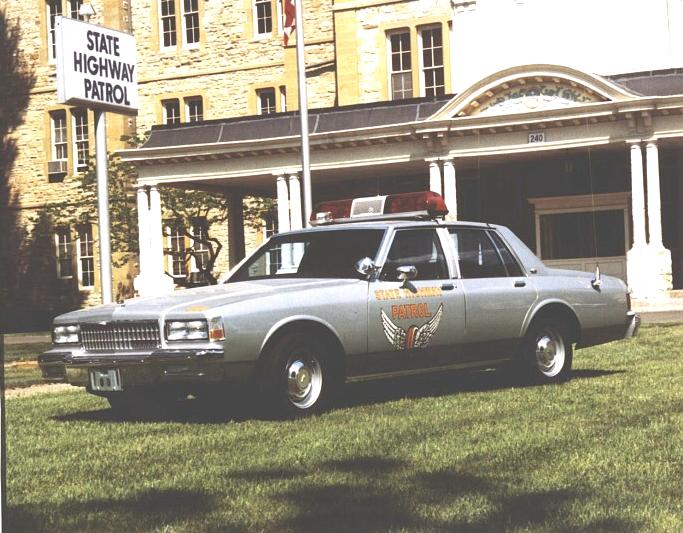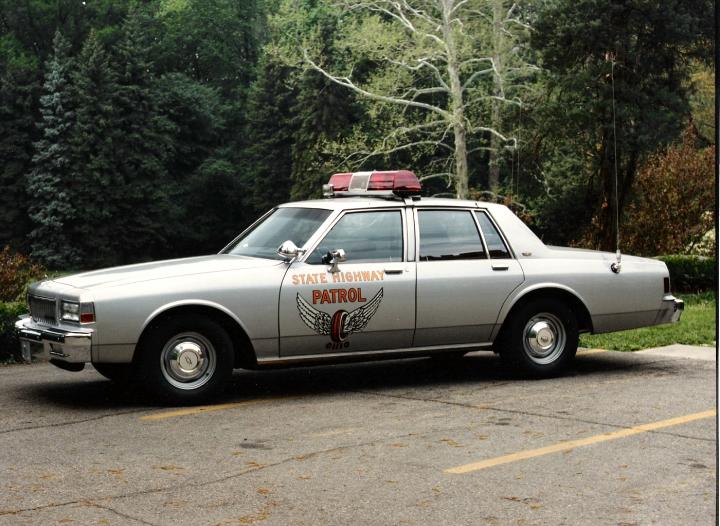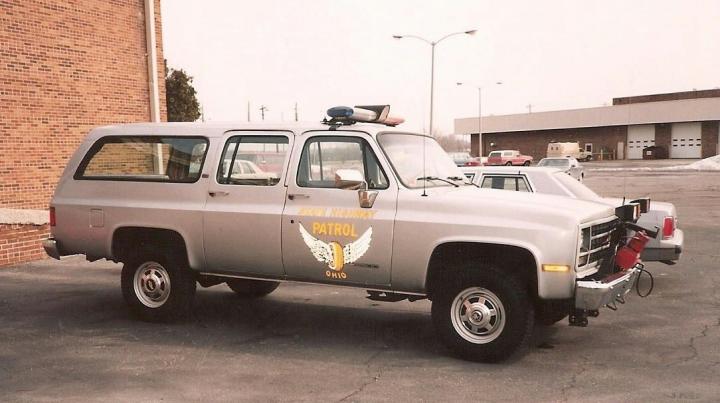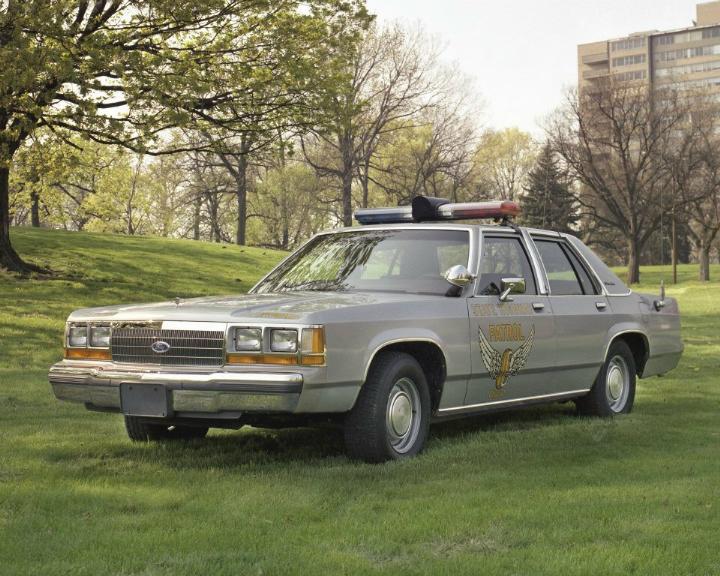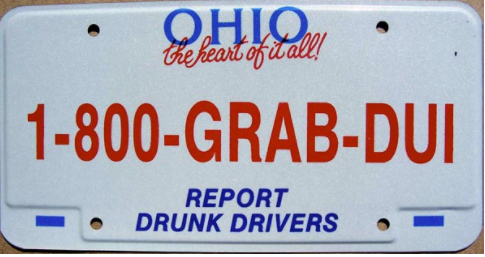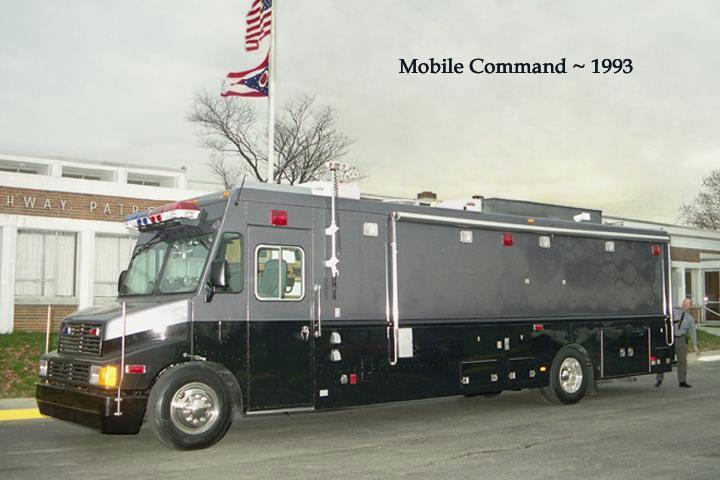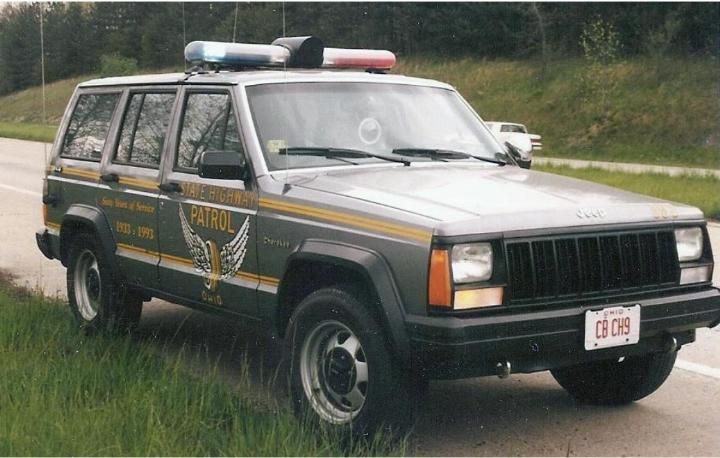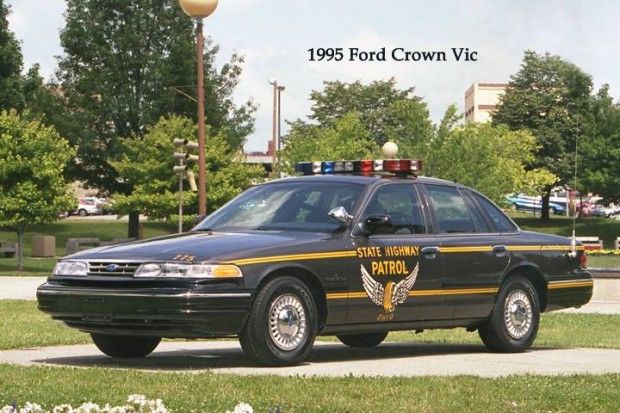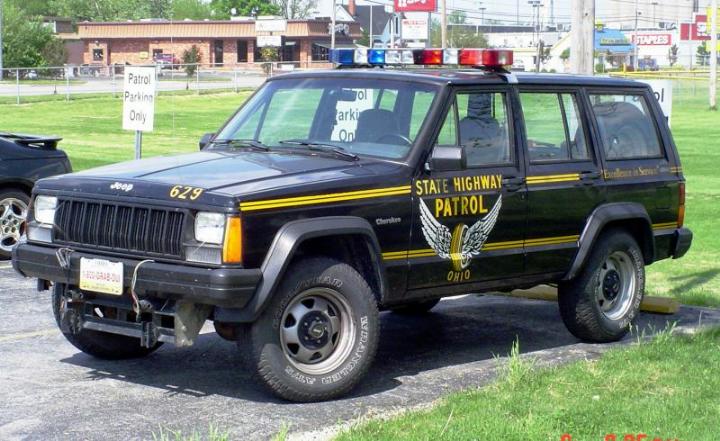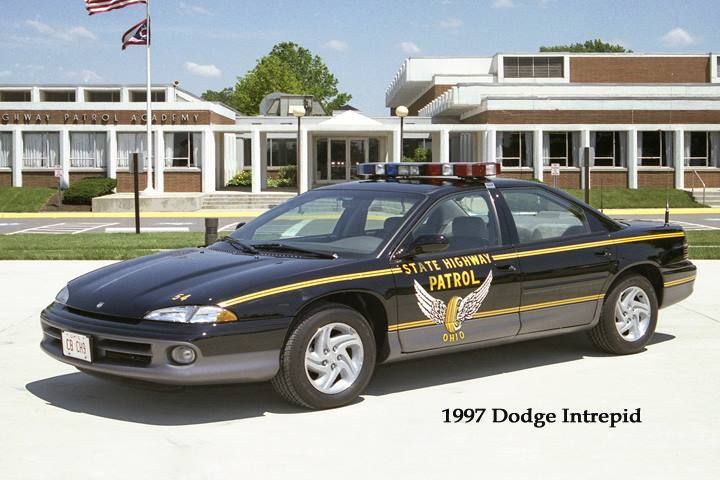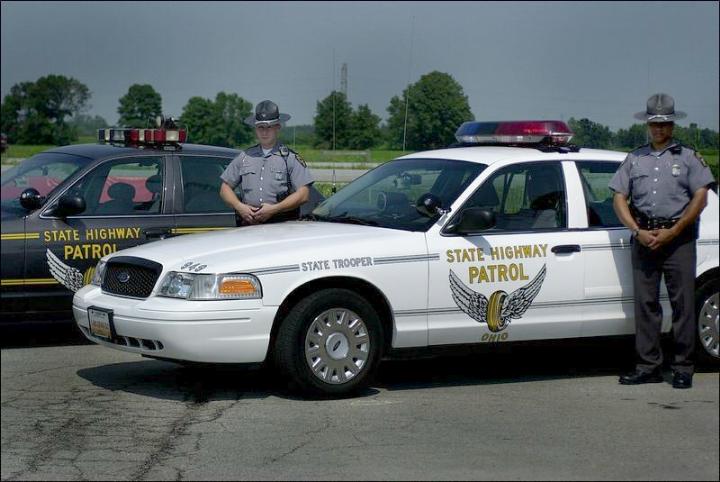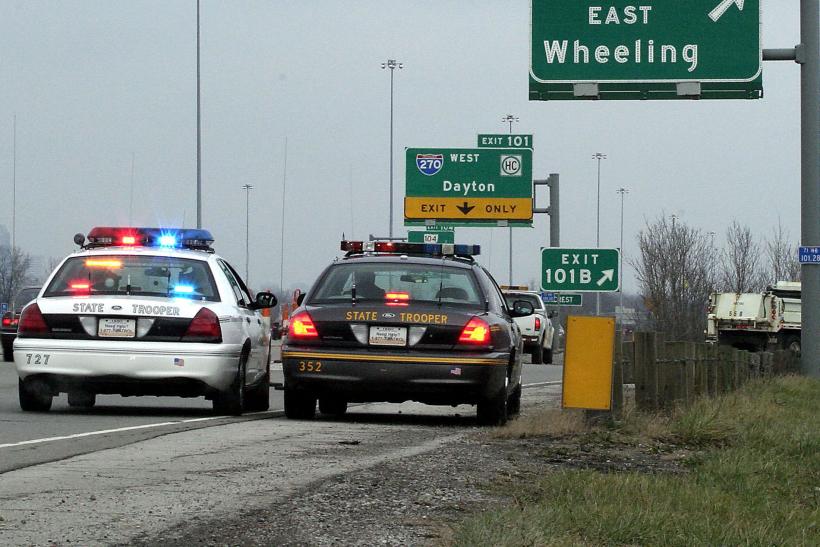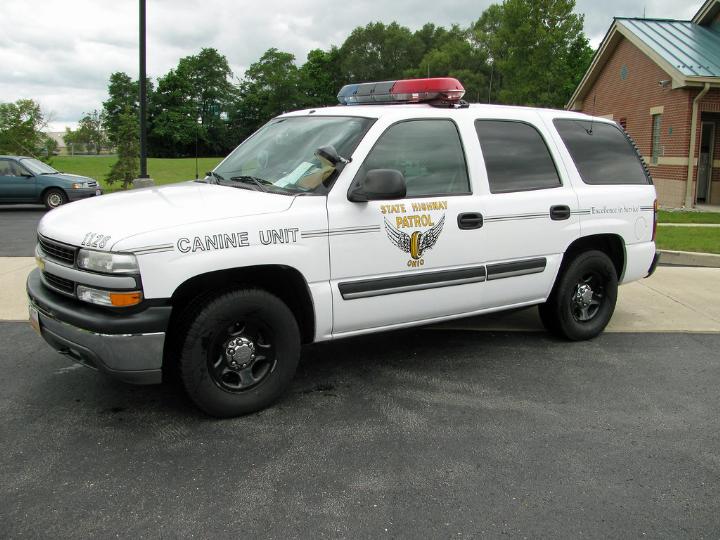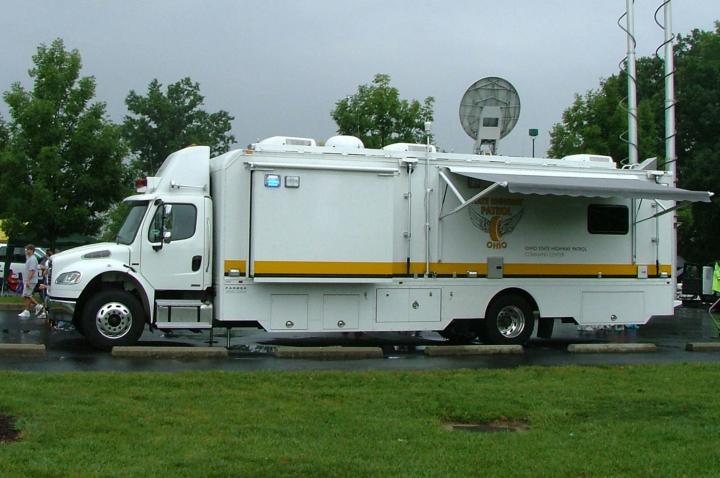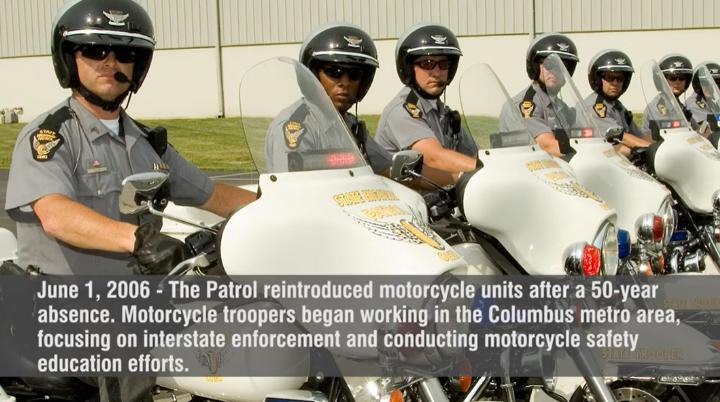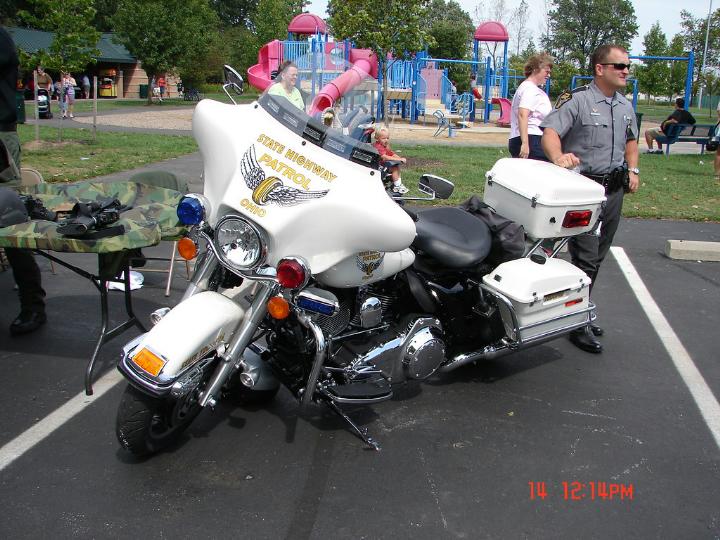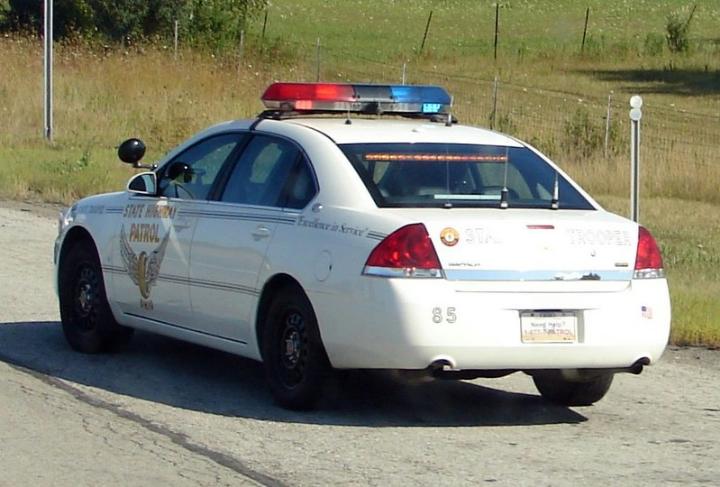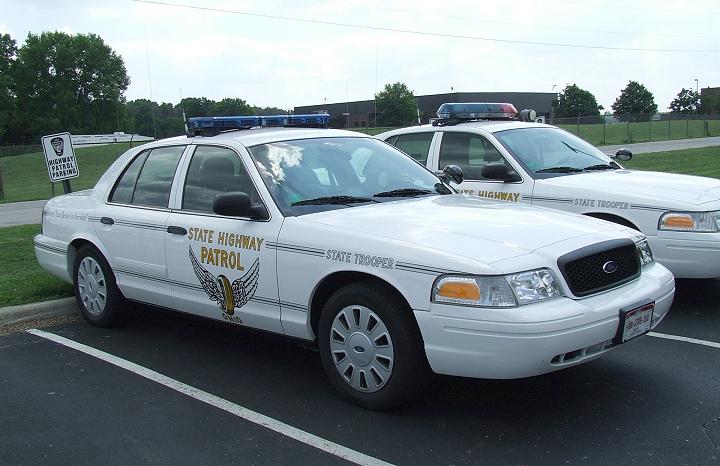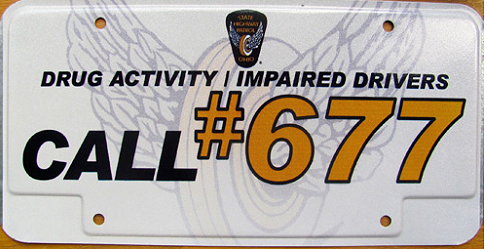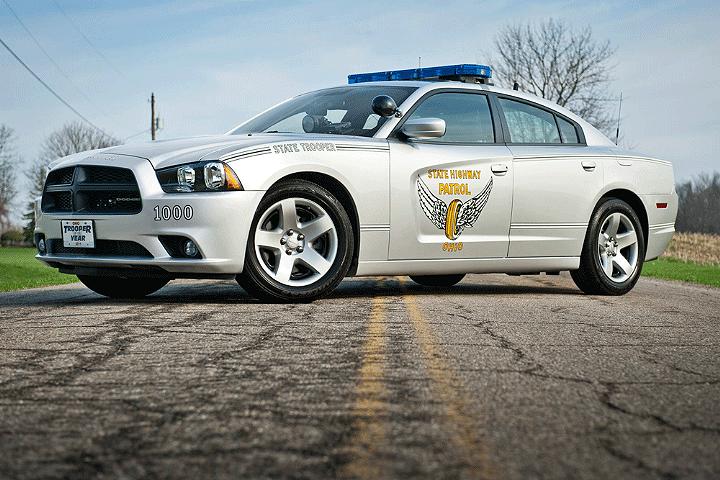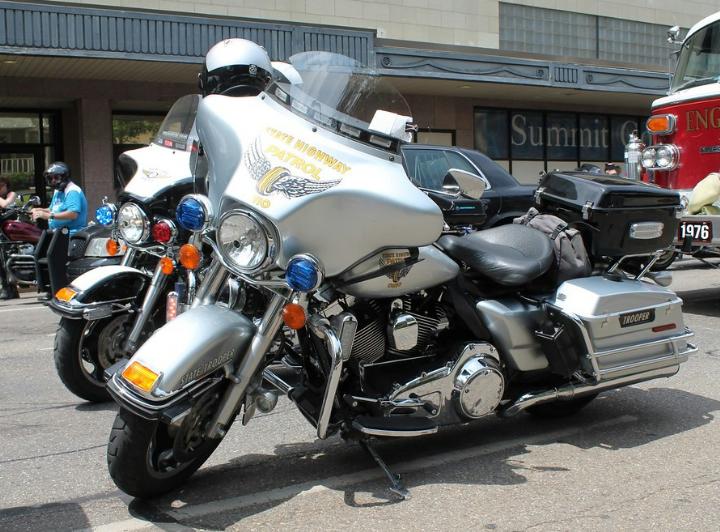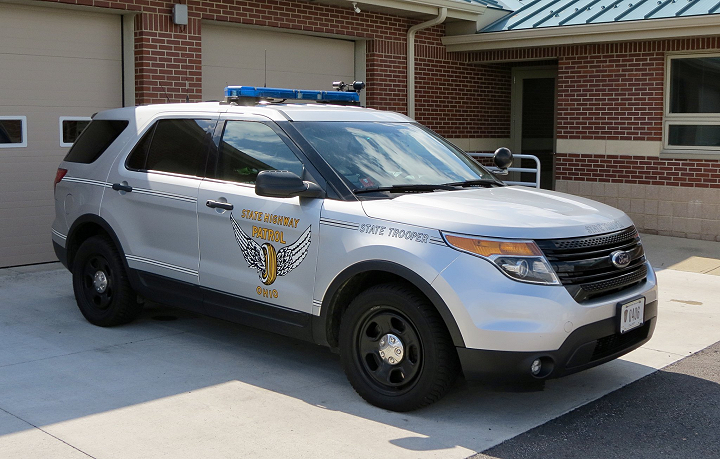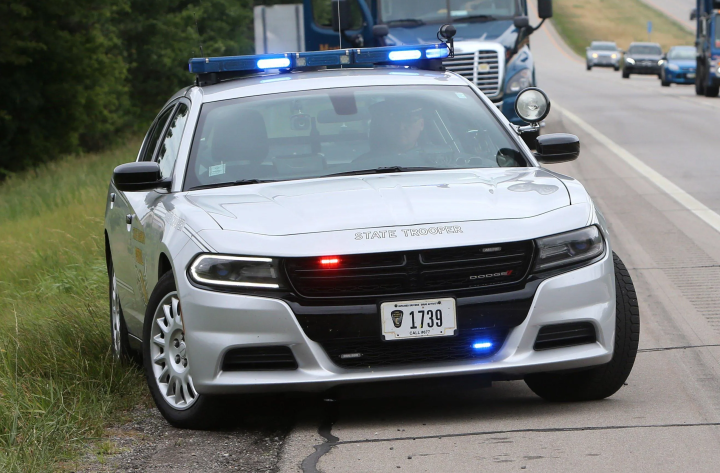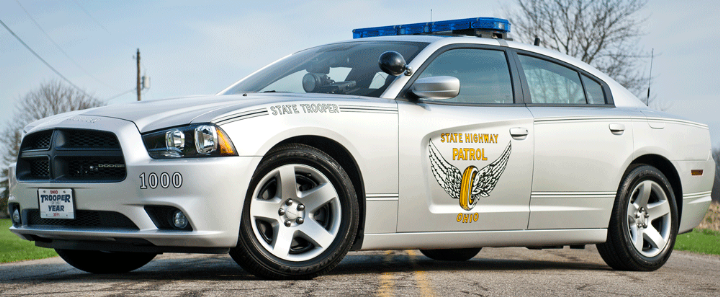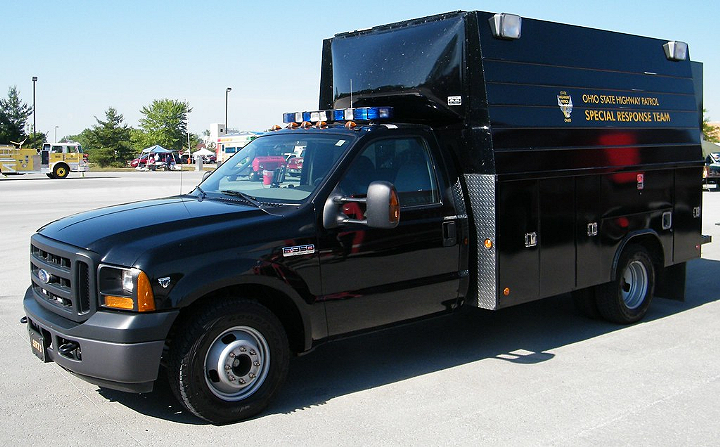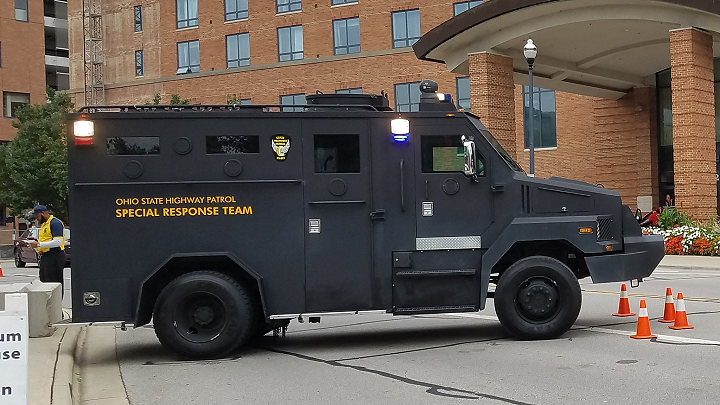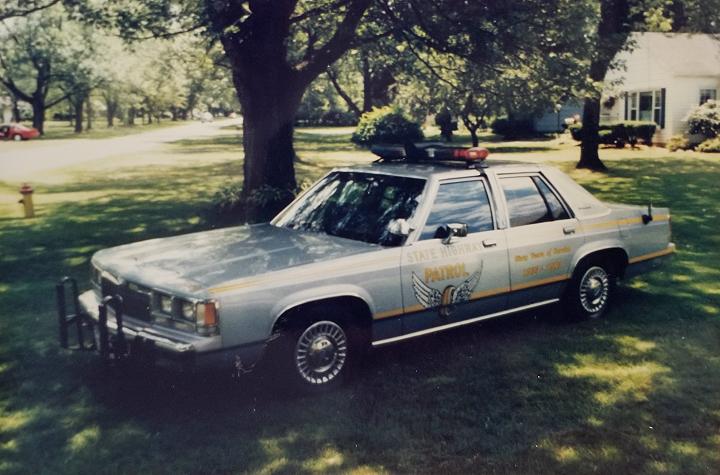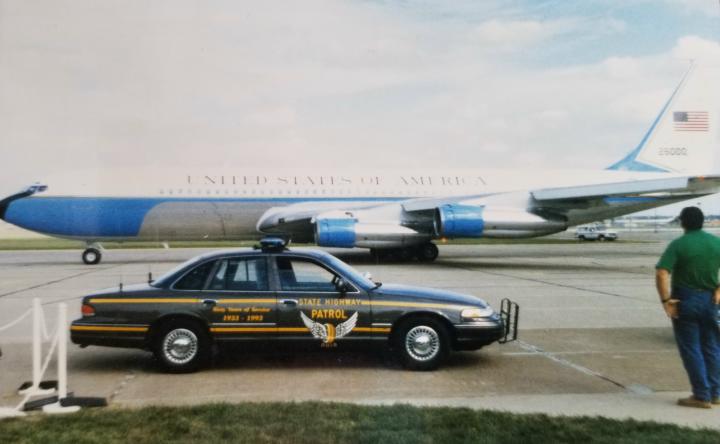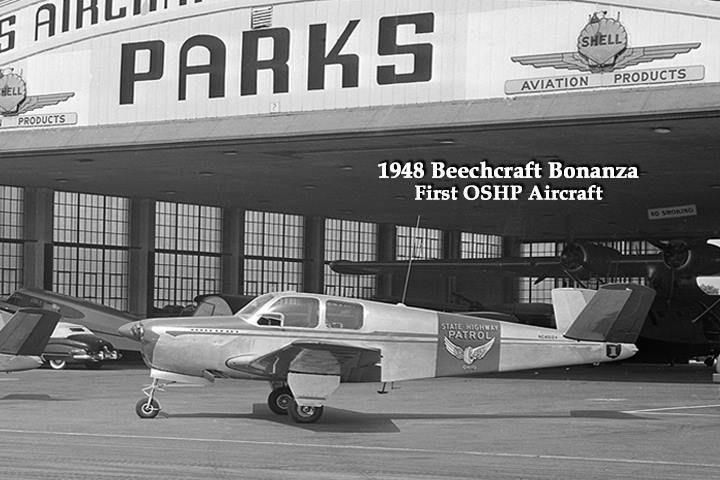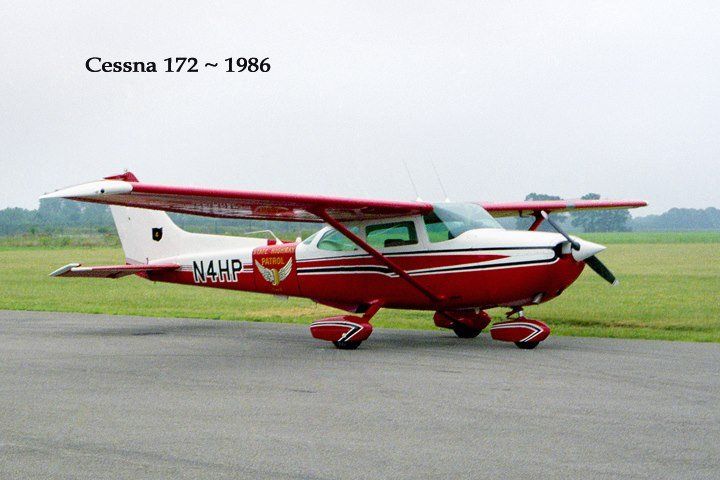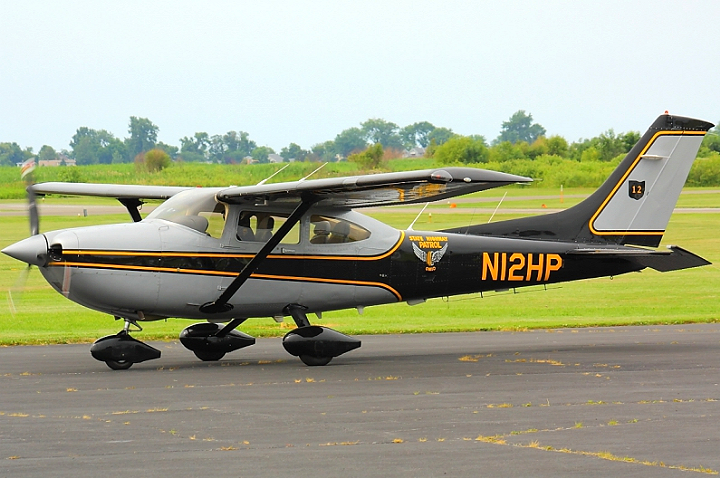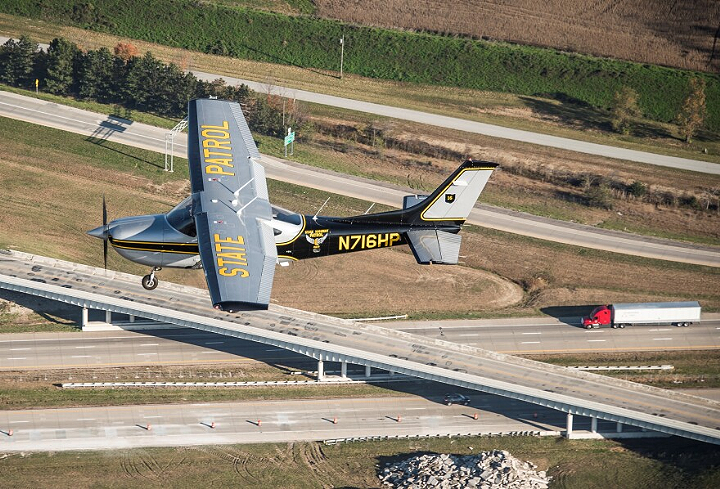(Ohio State Highway Patrol 1934)
Overview:
- 1933 – The first Ohio State Highway Patrol (OSHP) motorcycles and cars went into service
- 1952 – The OSHP began using stationary RADAR
- 1953 – The OSHP limited motorcycles to parades and special events
- 1955 – The OSHP discontinued using motorcycles completely
- 1956 – The OSHP began using ‘faintly marked’ cars without a redlight or siren to penetrate illegal drag racing (short term)
- 1959 – The OSHP performed the first air‐to‐ground speed check by airplane
- 1966 – The OSHP began using some white patrol cars for special tactical squads to reduce traffic crashes
- 1967 – The OSHP began using VASCAR in patrol vehicles
- 1972 – The OSHP introduced the Blue Max and ACE award program for auto larceny which awarded special license plates
- 1972 – The OSHP began using the MR‐7 moving radar
- 1972 – The OSHP finally switched to all white patrol cars
- 1976 – The OSHP changed from ‘Patrolman’ to ‘Trooper’. The cars now had ‘State Trooper’ on the rear instead of ‘State Patrol’
- 1977 – The OSHP began displaying ‘CB CH 9’ license plates
- 1977 – The OSHP began using the Yankee 911 fully enclosed lightbar
- 1978 – The OSHP purchased Ford Broncos with snowplows to strengthen response and rescue capabilities during snowstorms
- 1979 – The OSHP began using the MPH K-55 moving radar
- 1982 – The OSHP switched from white patrol cars to sterling silver patrol cars
- 1989 – The OSHP replaced the Yankee 911 lightbar with the Federal Signal Jetsonic
- 1992 – The OSHP switched from sterling silver cars to dark gray cars
- 1994 – The OSHP replaced the Federal Signal Jetsonic lightbars with Whelen Edge 9000 strobe lightbars
- 1992 – The OSHP switched from sterling silver cars to dark gray cars
- 2002 – The OSHP replaced the Whelen Edge strobe lightbars with Federal Signal Vista lightbars
- 2002 – The OSHP transitioned back to white patrol cars
- 2003 – The OSHP switched to a Computer Aided Dispatch (CAD) and Mobile Computer Terminals (MCT)
- 2006 – The OSHP reintroduced motorcycles into service
- 2011 – The OSHP replaced the red & blue Federal Signal Vista Lightbars for all blue Code 3 RX-2700CC LED lightbars
- 2012 – The OSHP returned to silver patrol vehicles
History:
Wednesday, November 15, 1933, was windy and bitter cold, with passing snow flurries. There had been talk of a formal graduation ceremony, but this idea was replaced with a simple swearing‐in and inspection. Captain Black, addressing his new force one final time before departure, urged his men to “at all times remember that promotion of true safety and the welfare of the people of Ohio should inspire and motivate your work.” With that, the (60) original patrolmen, now (54) patrolmen and six lieutenants, together with Captain Black took the oath of office from Common Pleas Judge J. F. Allyn of Ottawa County. Their 54 motorcycles and six Plymouth coaches were ready, as were the substations, and in the early afternoon the men broke camp.
For many, the trip to assigned substations was brutal, with the combination of weather and distance being almost unbearable. The story of Ptl. [later lieutenant] A. O. Smith gives a feel for the trip. He was assigned to Sidney, a distance of approximately 125 miles. As he told a reporter several years later, it was ‐3 degrees when he passed through Fremont, and he was forced to stop at every roadside stop and gas station to warm up. He tore up some newspapers and stuffed them into his uniform, and later bought a piece of cloth, cut holes in it, and wore it over his head (his cycle had no windshield or leg guards). For the last ten miles, he rode standing up and flexing his knees. But despite the hazardous journey, all (60) made it to their stations, and the Ohio State Highway Patrol was officially in operation.
An important first step was to set up a communications system. No plans for radio communications were in the works (a situation that would quickly change) so “call stations” were arranged. Should a sub‐post need to contact an officer, the message would be phoned to call stations (usually located at gasoline stations) along normal patrol routes, and attendants at the call stations would display a flag to signal passing patrolmen that there was a message. The call stations also provided a good chance to get to know local residents.
(Ohio State Highway Patrol 1937 Ford Tudor)
(Ohio State Highway Patrol 1938 Ford Tudor)
(Ohio State Highway Patrol 1939 Motorcycle)
in 1950, patrol officers assigned to the Baybridge area had a 15‐foot boat and trailer used (sparingly) for emergency and rescue situations.
Adding to the enforcement of speed limits in the 1950’s was a new technological device adopted by the Patrol. Several radar speed measuring devices were unveiled, and Patrolmen conducted highly visible demonstrations to familiarize judges and prosecutors with the new concept. The unit itself consisted of a “field box,” about the size of two ordinary shoe boxes, which was mounted on a carriage on the cruiser’s right rear fender and connected to a “speed meter” which registered the speed of passing vehicles. Long cables attached the unit to the cruiser’s battery. A radar team generally set up on the side of the highway, placing “radar speed control” signs up the highway in an effort to avoid the speed trap stigma. Because the patrol car was not mobile when using a radar unit, the officer radioed descriptions of violators’ vehicles to an “interceptor officer” waiting further down the road.
Motorcycles, which had been used only for parades and centerlining details since about 1953, were finally removed from all Patrol operations in 1955. The elimination of the final (27) motorcycles left the Patrol with (542) vehicles: (504) passenger cars, (19) Jeeps, (10) trucks, a station wagon, (5) emergency trailers, (2) airplanes, and a boat.
(Ohio State Highway Patrol 1954 Ford Mainline)
(Ohio State Highway Patrol 1957 Ford Fairlane Sunliner Convertible)
In 1956, “faintly marked” cruisers, special cars without sirens, red lights, or traditional markings, were put into operation. Marked only with one‐inch letters located under the window on the front door, these faintly marked vehicles were an answer to an increased incidence of organized “drag racing.” Difficult to arrest, drag racers often set up networks of lookouts who flashed signals to participants when a cruiser approached. It was hoped the faintly marked cruiser could penetrate to the center of the races before being discovered. The program was not popular, however, and the division was compelled to end it shortly after.
Ohio State Highway Patrol 1959 Chevy Slicktop
(Ohio State Highway Patrol 1958 Ford)
(Ohio State Highway Patrol 1958 Ford)
(Ohio State Highway Patrol 1958 Ford)
(Ohio State Highway Patrol 1959 Ford)
(Ohio State Highway Patrol 1960 Ford)
(Ohio State Highway Patrol 1961 Chevy Biscayne)
(Ohio State Highway Patrol 1962 Ford Galaxie)
(Ohio State Highway Patrol 1964 Chevy Biscayne)
(Ohio State Highway Patrol 1965 Ford)
(Ohio State Highway Patrol 1965 Ford Custom)
In September 1966 the Ohio State Highway Patrol formed two four‐car tactical squads. Assigned to areas with historically high crash frequencies, the teams were greatly successful in reducing crash rates wherever they were assigned. Cars used by the squads were white ‐‐ the first white cars ever used for enforcement duty ‐‐ marking the beginning of the end for black cars. By 1972 all Ohio State Highway Patrol cars were white.
(Ohio State Highway Patrol 1966 Ford Custom)
(Ohio State Highway Patrol 1966 Chevy Biscayne)
(Ohio State Highway Patrol 1967 Plymouth Fury tactical Squad patrol car)
Shortly after the formation of the tactical squads, the division added yet another new tool to enhance speed enforcement. VASCAR (Visual Average Speed Computer and Recorder), a device enabling electronic speed measurement from a variety of positions and directions, was installed in (39) regular patrol cars in July 1967. Patrolmen certified as operators found the units to be highly effective; they reduced high speed pursuits and greatly lessened the difficult practice of following and “pacing” violators to determine speed. After initial success with the units, additional ones were purchased, and by 1970 there were over 150 VASCAR units in service. The Highway Patrol eventually phased out the VASCAR units in patrol cars but still used time over distance speed enforcement through the aviation section.
(Ohio State Highway Patrol 1968 Chevy Biscayne ‘TAC Squad’ patrol car)
(Ohio State Highway Patrol 1968 Chevy Biscayne)
The growing frequency of civil disturbances led to the purchase of a special “command post” vehicle in June 1968. The command post consisted of an armored tractor and semi‐trailer outfit equipped with communications systems, riot equipment, and a command center.
The ACE and Blue Max awards were introduced in 1972. The Blue Max award, a distinctive medal and certificate, would be given to the officer attaining the most stolen vehicles with on‐the‐spot apprehension of suspects in one year. For each such recovery, the officer received a lightning bolt decal to place on his patrol car door to signify the accomplishment. The Ace award would be given to any officer recovering five stolen vehicles with on‐the‐spot apprehensions during a calendar year (and therefore receiving five “bolts”), became an integral part of the Blue Max program. Recipients of these awards also received special ACE license plates for their patrol vehicle.
1972 ACE License Plate
1973 ACE License Plate
1990’s ACE license plates (red are even years, blue are odd years)
(Ohio State Highway Patrol 1968 Chevy Biscayne)
(Ohio State Highway Patrol 1970 Plymouth Fury – Yes, it’s black)
(Ohio State Highway Patrol 1971 Chevy Biscayne)
(Ohio State Highway Patrol 1972 AMC Ambassador)
(Ohio State Highway Patrol 1972 Plymouth Fury)
Speed enforcement took another giant stride in 1972 with the introduction of the MR‐7 moving radar. With the MR‐7, officers were (for the first time) able to obtain accurate readings of motorists’ speeds while the patrol car were moving on the highway ‐‐ even while moving in the opposite direction of a violator on a divided highway. The first MR‐7s were placed into service in November 1972.
(Ohio State Highway Patrol 1973 Chevrolet ‘Slick Top’)
(Ohio State Highway Patrol 1974 Chevrolet)
(Ohio State Highway Patrol 1975 Plymouth ‘Slick Top’ with Yankee grill lights on the front fenders)
In 1973 patrol cars were equipped with fuel transfer units. In the first year of the program, 6,687 gallons of gasoline were transferred to disabled vehicles to enable drivers to breach a place where they could replenish their supply. Motorists receiving fuel transfers were provided an envelope to voluntarily mail reimbursements for gasoline received, and during that first year, reimbursements more than covered the cost of fuel dispensed. These fuel transfers were eliminated from patrol cars in the early 1990’s.
In 1976 the first female entered the Ohio State Highway Patrol Academy, and the designation ‘Patrolman’ was changed to ‘Trooper’. As a result, the wording on the rear of patrol cars was changed from ‘State Patrol’ to ‘State Trooper’.
(Ohio State Highway Patrol 1977 Pontiac Catalina)
In 1977 the Ohio State Highway Patrol switched from using revolving beacon lights to the Yankee 911 fully enclosed lightbar.
One of the greatest difficulties experienced during the blizzards of 1977 and 1978 were that regular patrol cruisers were ill‐suited to traverse the blizzard‐swept rural roads of Ohio. After months of study, the division purchased (20) four‐wheel drive Ford Broncos, each equipped with a snow blade, to strengthen response and rescue capabilities.
A tool which came into use unceremoniously in the early 1960s also was of great assistance ‐ the citizens band (CB) radio. Over 10,000 requests for assistance were received over the CB, greatly reducing the response time required under normal circumstances. The division had, for several years, touted the use of CBs to report emergencies and request assistance, and in fact had averaged around 50,000 CB broadcasts over emergency channel 9 in the two years preceding the blizzard of 1977. Two weeks later, license plates reading “CB CH9” were placed on marked Patrol cars as a further reminder that troopers routinely monitor the CB emergency channel.
1979 saw the introduction of the MPH K-55 moving RADAR.
(Ohio State Highway Patrol 1977 Ford LTD)
(Ohio State Highway Patrol 1978-1982 Ford Fairmont test vehicle)
(Ohio State Highway Patrol 1979 Chevy Impala)
On October 25th, 1979 the State of Ohio enacted Ohio Revised Code 4549.13 ‘Marking and equipment for motor vehicle used by traffic enforcement officers’:
“Any motor vehicle used by a member of the state highway patrol or by any other peace officer, while said officer is on duty for the exclusive or main purpose of enforcing the motor vehicle or traffic laws of this state, provided the offense is punishable as a misdemeanor, shall be marked in some distinctive manner or color and shall be equipped with, but need not necessarily have in operation at all times, at least one flashing, oscillating, or rotating colored light mounted outside on top of the vehicle. The superintendent of the state highway patrol shall specify what constitutes such a distinctive marking or color for the state highway patrol.”
The law put an end to ‘slick top’ patrol cars and is still in effect today.
(Ohio State Highway Patrol 1980 Plymouth)
(Ohio State Highway Patrol 1981 Plymouth Gran Fury)
In 1982 the Ohio State Highway Patrol switched from white patrol cars to sterling silver patrol cars.
(Ohio State Highway Patrol 1983 Ford LTD)
In 1983 the Yankee 911 lightbars received a clear halogen ‘takedown’ light on the front of the lightbar to provide Troopers with more lighting during nighttime traffic stops.
(Ohio State Highway Patrol 1984 Plymouth Gran Fury)
(Ohio State Highway Patrol 1985 Ford LTD Crown Victoria)
(Ohio State Highway Patrol 1986 Plymouth Gran Fury)
(Ohio State Highway Patrol 1988 Chevy Caprice)
(Ohio State Highway Patrol 1988 Chevy Caprice)
(Ohio State Highway Patrol 1988 Chevy Suburban)
In 1988 the Chevy Suburban replaced the Ohio State Highway Patrol’s aging Ford Bronco’s.
(Ohio State Highway Patrol 1989 Ford Crown Victoria)
In 1989 the Yankee 911 lightbar was replaced with the Federal Signal Jetsonic.
(Ohio State Highway Patrol 1990 Chevy Caprice)
In August of 1991, the Ohio State Highway Patrol with the support of MADD (Mothers Against Drunk Driving) launched the 1-800-GRAB-DUI program. All OSHP marked patrol cars bore these special license plates that directed citizens who observed a potential drunk driving offender to call the toll free number to report the observation. These license plates replaced the ‘CB CH 9’ plates on the back of the patrol cars. In some occasions the ‘CB CH 9’ plates were moved to the front of the cruiser, but for the most part the plates were discarded. Different variations of this plate were used up through 2012.
(Ohio State Highway Patrol 1992 Ford Crown Victoria)
In 1992 the patrol cars switched from sterling silver to dark gray. All cars regardless of if they were silver or dark gray received yellow stripes down the side and a message on the rear doors that read ‘Sixty Years of Service 1933-1993’ for the highway patrol’s 60th anniversary.
(Ohio State Highway Patrol 1993 Mobile Command Center)
(Ohio State Highway Patrol Jeep Cherokee)
In 1994 the Ohio State Highway Patrol replaced the Federal Signal Jetsonic lightbars with Whelen Edge 9000 strobe lightbars.
(Ohio State Highway Patrol 1996 Jeep Cherokee)
(Ohio State Highway Patrol 1997 Ford Taurus test vehicle)
(This 1997 Dodge Intrepid was a test vehicle used on patrol)
Around 2001 the Ohio State Highway Patrol launched a new license plate to be displayed on all its marked patrol vehicles. The same BIRTHPLACE OF AVIATION base plate was used, however this time, the center field of the plate had the trademark winged-wheel motif of the OSHP silkscreened in grey. The horizontal center span had the words Need Help? which was silkscreened in dark blue over 1-877-7-PATROL in red. These plates were used while the 1-800-GRAB-DUI and CB CH 9 plates continued to be displayed on OSHP vehicles as well. The usage of this type continued until approximately 2008.
(2002 white Ford Crown Victoria next to a 2001 gray Ford Crown Victoria)
In 2002 the Ohio State Highway Patrol replaced the Whelen Edge strobe lightbars with Federal Signal Vista lightbars that used a strobe and LED combination. The cars also received red and blue Federal Signal LED lights in the rear window, as well as a direction arrow. The siren was upgraded to a Federal Signal Smart Siren so that all of the siren and light controls could be contained in one unit.
In 2002 the Ohio State Highway Patrol transitioned back to white patrol cars.
In 2003 the Ohio State Highway Patrol introduced Computer Aided Dispatch (CAD) and Mobile Computer Terminals (MCT) in patrol cars.
(Ohio State Highway Patrol 2005 Chevy Tahoe Canine Unit)
In 2006 the MARCS (Multi Agency Radio Communication System) 800-megahertz radio system began statewide communications throughout the state.
(Ohio State Highway Patrol 2007 Freightliner Farber Vehicle Specialties Mobile Command Center)
In 2006 the Ohio State Highway Patrol reintroduced motorcycles in the Columbus metro area.
(Ohio State Highway Patrol Harley Davidson)
(Ohio State Highway Patrol 2008 Chevy Impala)
(Ohio State Highway Patrol 2008 Dodge Charger)
(Ohio State Highway Patrol 2011 Ford Crown Victoria (foreground) with a Code 3 RX-2700CC LED Lightbar)
In 2011 the Ohio State Highway Patrol changed out the red & blue Federal Signal Vista Lightbars for all blue Code 3 RX-2700CC LED lightbars. The cars received red LED lights in the front grill and blue LED lights in the rear window.
In 2011 the Ohio State Highway Patrol unveiled the ‘Call #677’ license plate. #677 is the Ohio State Highway Patrol’s cell phone contact number. This plate replaced the 1-800-GRAB-DUI and 1-877-7-PATROL license plates.
(Ohio State Highway Patrol 2012 Dodge Charger)
With Ford discontinuing the Crown Victoria after 2011, the Ohio State Highway Patrol began purchasing 2012 Dodge Chargers. They also switched from white patrol cars back to silver patrol cars.
(Ohio State Highway Patrol 2012 Harley Davidson)
(Ohio State Highway Patrol 2014 Ford Police Interceptor Utility)
(Ohio State Highway Patrol 2016 Dodge Charger)
(Ohio State Highway Patrol Ford Police Interceptor Utility)
In mid-2016, and for the first time since 1942, the Ohio State Highway Patrol began to display numbered license plates on marked patrol vehicles. The new plate is an entirely silkscreened license plate with a reflective white background. The plate has a thin gold stripe outline that covers the embossed perimeter of the plate. IMPAIRED DRIVERS/DRUG ACTIVITY is silkscreened in black between the upper mounting holes. The OSHP color emblem occupies the left center field of the plate followed by the trooper’s assignment number in black silkscreened numerals. CALL #677 is silkscreened in black in the bottom center of the plate. The number is the Troopers unit number that is assigned to that Trooper throughout their career, and not the car number. This is the number that the Trooper will identify themself with on the radio.
Car #1000:
Every year Troopers vote for a Post Trooper of The Year at their assigned facility. District headquarters then look at the winner of each patrol post and picks one of them to be the District Trooper of The Year. General headquarters then looks at all of the District Trooper of The Year recipients and picks one Trooper to be the State Trooper of The Year. In addition to the award and uniform ribbon, the State Trooper of The Year is also given Car #1000. Car #1000 is a brand-new car with the latest equipment. The #1000 number assignment identifies it as the State Trooper of The Year car. At the end of the year the car is re-numbered and a new car is assigned #1000 for the next Trooper of The Year.
Other Vehicles:
(Ohio State Highway Patrol Special Response Team (SRT) Truck)
(Ohio State Highway Patrol Special Response Team (SRT) Lenco BearCat)
(Ohio State Highway Patrol Crime Scene van)
IS-480 Project:
Around 1992 the Ohio State Highway Patrol began patrolling 42-miles of Interstate 480 that ran from the Ohio Turnpike in North Ridgeville east through Cleveland to the Ohio Turnpike in Streetsboro. The State Troopers that worked this road were assigned to Cleveland Post 18 (Garfield Heights) which was an investigative (plain clothes) post.
The (3) Ford Crown Victoria’s and (2) Jeep Cherokees that patrolled this road were equipped with push bumpers with additional directional warning light in the rear window (the Jeeps had them on the back of the Federal Signal Vision lightbar).
The patrol cars assigned to IS-480 (Post 18) were equipped with Mobile Data Terminals (MDT) that were connected to the Cuyahoga Regional Information
System (CRIS) since the Troopers were working in Cuyahoga County. This allowed Troopers to run driver’s license and license plates from inside the patrol car.
The Troopers here also had a Chevy IROC Camaro to use for traffic enforcement. The Camaro was one of several Camaro’s that had been seized by the highway patrol. While all of the seized Camaro’s received highway patrol markings and lights, this was the only Camaro that was actually used for traffic enforcement. The Troopers assigned to IS-480 received special training from an academy driving instructor before they could use the Camaro on Patrol.
For more information about the Camaro, check out Ohio State Highway Patrol IROC-Z Camaro.
The IS-480 patrol post only operated for a few years before all of the ‘uniformed’ officers were re-assigned to other patrol posts returning Post 18 to only being used as an investigative post.
In 2007 the Highway Patrol returned to patrol the interstates around Cleveland due to the number of traffic fatalities.
Aviation:
in 1948 the Patrol secured $7,800 in funding for a Beechcraft Bonanza model 30 airplane.
Traffic enforcement took another giant leap on July 4, 1959, when the first air‐to‐ground speed check was held on Route 40 between New Rome and West Jefferson in western Franklin County. The highway was marked in quarter‐mile zones and an observer clocked vehicles as he and the pilot flew overhead. Violators were reported to an interceptor on the ground. The program proved very successful, and airspeed zones soon appeared in every district.
The success and promise of the air‐speed program led to the purchase of two Champion airplanes and a helicopter in 1960. With five aircraft now in the fleet, multiple air‐speed operations could now be undertaken at the same time without compromising civil defense preparedness. The helicopter crashed two years later, injuring two patrol officers and one auxiliary, and was replaced three months later by a new Hiller helicopter.
The helicopter flew several impressive and dangerous rescue missions in the early 1960s. The first, in late 1962, was at the scene of an airplane crash on dangerous Lake Erie ice. Patrol pilots flew to the scene, found there were no survivors, and recovered the bodies. A couple months later, the helicopter was again dispatched to Lake Erie, this time to rescue four fishermen stranded on an ice floe. A similar mission rescued two U. S. Coast Guardsmen the following
year.
The helicopter flew several impressive and dangerous rescue missions in the early 1960s. The first, in late 1962, was at the scene of an airplane crash on dangerous Lake Erie ice. Patrol pilots flew to the scene, found there were no survivors, and recovered the bodies. A couple months later, the helicopter was again dispatched to Lake Erie, this time to rescue four fishermen stranded on an ice floe. A similar mission rescued two U. S. Coast Guardsmen the following
year.
Ohio State Highway Patrol Cessna 182T Skylane
In this June 27, 2012 photo, Ohio State Highway Patrol trooper Bryan Dail records times for speeders on Ohio Route 2 near Vermilion, Ohio.





